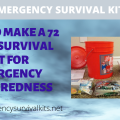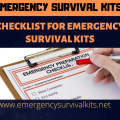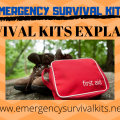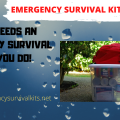Your first consideration for building a Survival Kit is what types of events you are planning for. You will most likely tailor your kit to match your specific needs and goals. I will be covering only the fundamental aspects of what you need for most events. This won’t cover every event, and you can’t factor in every possible scenario. However, if you have an emergency kit or basic survival kit in position you will already be better prepared than most people when catastrophe takes place.
Storage
You need some sort of bag to hold all your survival items in, otherwise you don’t have a survival kit, you have a pile of stuff. Having a stack of things won’t work if you have to vacate hastily in an emergency situation. Having everything in a GOOD (Get Out Of Dodge) Bag is a much better idea when you need to relocate in short order. Do you need the absolute best survivalist backpack or will that smelly old duffel bag work for your survival kit storage? Having a proper backpack will provide advantages like ease of moving if you find yourself traveling around by foot but waiting around to put your kit together until you acquire the best backpack is not a smart idea. Getting all of your items together in some type of bag that can be grabbed and carried around quickly is more important. However, 5 plastic shopping bags or that big suitcase you got from your mother probably aren’t going to meet the portability criteria. You should have an adequate size bag that can fit enough survival equipment for 3 days minimally. A large duffel bag can do the trick until you determine which backpack system fits your needs and budget the best.
Water
Clean refreshing water, it’s not just for the health buff in you. It also doubles as a lifesaver when you don’t have convenient access to liquids for that ever important game we call life. Many survival guidelines say that you should have 1 gallon per person per day. If your survival kit is going to be portable then you should probably go with the bare minimum of 1 liter per person per day. The gallon jugs would take up too much room, leaving too little space for other essential items, and would add an extra 25 pounds to what you would have to carry. Since your survival kit is going to supply you with a minimum of 3 days, you will want to pack three 1 liter bottles of water. Next, you should pack a few items that will assist with water collection and purification. A collapsible water bucket, can help you gather water from a stream or collect rain running off of your shelter, and it takes up almost no room in your survival kit. Purification can be as straightforward as boiling the water on the fire you made and using iodine tablets, or can get more in-depth using filters. You should boil water for 5 minutes minimum but 20 minutes is a better time to aim for. There are ways to boil water without a pot or kettle but I suggest you buy a small camping pot with a lid to put in your survival kit. This will become useful for more than just boiling water. When storing the pot or kettle in your kit, take advantage of the space inside the pot to keep spices or other small things.
Food
There are many types of backpack meals and high calorie energy bars you can keep in your survival kit. Any food you pack should have a long shelf life so that you don’t have to rotate your survival kit food stock every other week. Backpack meals are usually freeze-dried and only require boiling water to enjoy. MRE’s or “Meals Ready To Eat” are an all in one meal contained in individual packages. This will come down to personal preference. Don’t forget some utensils. You can splurge on a camping spork for 7 dollars, or your local dollar store should have utensils that will do the trick. You might consider covering each utensil in something to prevent them from clanging together. This will help ensure you don’t rouse Sasquatch if you find yourself walking past his den.
Clothing
You should pack enough clothes to get you through a few accidents like falling in to a river or sliding down a muddy embankment. You may not be a klutz but stuff happens. You might find yourself walking a whole lot more than you want to, so your survival kit should have a comfortable but durable pair of boots. A few pairs of wool socks and long underwear will go a long way in keeping you warm. You should also pack a pair of comfortable pants. Your skinny jeans are not comfortable regardless of how fantastic you think you look in them and zubaz went out of style years ago. You don’t need to be decked out in full “deer hunter” gear but something comfortable and somewhat tough is a must. You should pack a two or three long sleeve shirts. Remember a long sleeve shirt can double as a short sleeve shirt simply by rolling up the sleeves. Short sleeve shirts on the other hand cannot double up as long sleeve shirts. You should also bring a light rain resistant jacket which can help keep the wetness out if needed. Lastly, don’t forget a hat. No survival kit is complete without a hat. You could go with the Crocodile Dundee look, a wool hat or even a baseball hat will help protect you from the sun and keep some of your precious heat from escaping that head of yours.
Shelter
You should have some sort of shelter materials in your emergency kit. The 5 person tent with the extra room probably isn’t sensible. You can go with a small 1 person tent, or a tarp and some sturdy cord or parachute cord. If your survival bag still has a good deal of room you can add a bedroll or “space blanket”. If you choose a tarp, make sure the tarp is nylon or polyester and has reinforced grommet holes to make it less complicated to build a shelter with.
First Aid Kit
You can buy many different kinds of first aid kits. You probably don’t need the deluxe home surgeon first aid kit. A basic first aid kit should do the trick. Of course you can put together your own if you have a good grasp on first aid. If you don’t have first aid knowledge then I recommend you pack a book on basic first aid in your survival kit along with the actual first aid kit. Having all the tools without knowing how to use them would be bad. Remember, a mind is a terrible thing to waste. Look for something small like an army first aid field manual. The Time-Life First Aid series might look great on your bookshelf but is too bulky for your emergency kit bag.
Everything Else
This next section isn’t a comprehensive be-all and end-all list. It is solely listed as a starting point. You should tailor your survival kit to fit circumstances that you will most likely find yourself in, based on your geography. You cannot forget your survival knife. You will need waterproof matches, a few lighters and a flint rod. You should have a few flashlights. These can be battery-powered or hand crank models but if they are battery-powered don’t forget to have extra batteries. A small sewing kit with a heavy-duty sewing needle can be quite helpful. A few flares to use for signaling. A few candles for warmth or light should be included. You should definitely pack a small survival fishing kit. You don’t need to win a bass pro title, you just need to be able to catch food if possible. A compass can be handy but make sure you know how to use one before you actually have the need to. A few plastic garbage bags can serve many purposes. Some sort of multi-tool should be readily available as well and of course a survival manual of some sort. You should also think about having a small sum of money in your survival bag.
These items don’t make up the ultimate survival kit for anyone or any particular survival situation. You will need to identify what situations you are preparing for and modify the contents accordingly. However if you put together a basic Survival Kit like we have listed, you will be better prepared than most people when disaster strikes and being mostly prepared is better than not being prepared at all now isn’t it?
Article Source: Build A Basic 3 Day Survival Kit








